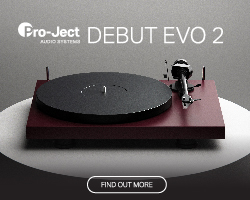RUSS ANDREWS RANS-1 NETWORK SWITCH REVIEW
In this review, Chris Baillie takes a look at the Russ Andrews RANS-1 costing £956.50 without mains cable or £989.00 with 1m Russ Andrews’ yellO.

The RANS-1 is a two-box switch with an external PSU
Many might not appreciate it, but Russ Andrews is probably behind an awful lot of the philosophies that we audiophiles have been following for years. Russ was instrumental as a dealer in the 70s, working with both Linn and Naim, reportedly being a key influence in convincing Naim to sell to the domestic market and being their first dealer! An early adopter of the benefits of using high-quality speaker cables and interconnects, he was a guiding light in carrying over those thoughts and ideas to mains cables, having already released his own mains noise suppression products. He worked with Kimber Kable to help bring them to the market. Russ was similarly pioneering with ideas on light but stable stands, on which to place speakers, turntables, and other system components. Indeed, Russ Andrews did an awful lot to help the industry understand these things back in the ’80s and ’90s.
In both my current and previous houses, I followed his guides when setting up dedicated mains spurs and earth. His designs follow fundamentally solid ideas and principles and many of us wouldn’t have even known how to go about setting up our systems for optimum performance if it wasn’t for his pioneering work.
Network Switches have become hot property within the high-end network music world these last couple of years and the RANS-1 is the third I’ve had in my system within the last year, and the second I’ve had the pleasure of reviewing this month! I have found the inclusion of such a switch to make significant improvements to my system, in terms of both lowering the noise floor and musical enjoyment. Here Russ has produced a switch following his established principles of lowering noise and optimising the PSU.
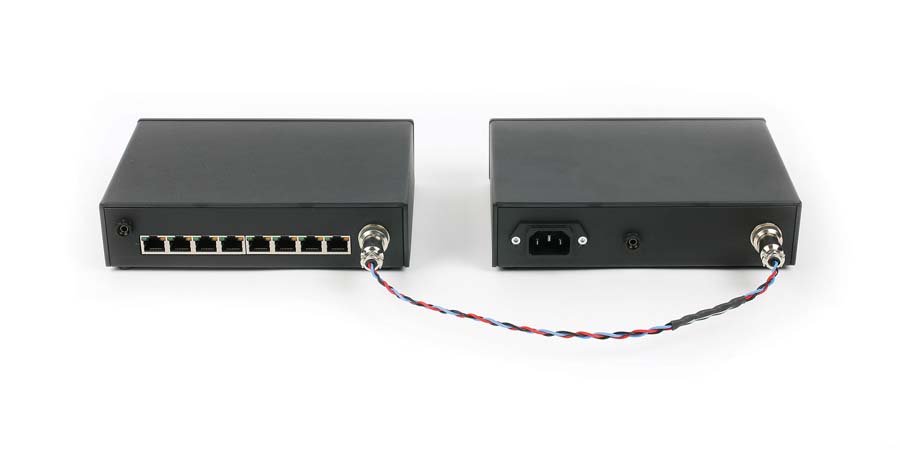
The two boxes are connected by an umbilical.
DESIGN AND BUILD
Replacing the EE 16Switch, reviewed last month, I have to say aesthetically the RANS-1 was breath of fresh air. My system is set up in a shared living space and I can tuck it away in the corner, on a cabinet and it blends in nicely. A two-box affair, there’s the main switch with an external power supply, with the two connected by a supplied PBJ connector. As with most of Russ’s cables, this is braided for enhanced RFI rejection properties.
There’s just a blue light on the front panel of each unit to indicate power, with both power and Ethernet input/output to the rear. Supplied with the units is one of Russ Andrews yellO mains cables, which connects to the PSU – I had forgotten the extension lead, used to plug in my TV and PVR is actually a Russ Andrews yellO power block.
Build quality is purposeful and the casing is ABS plastic, very light but solid. As usual for an RA product, all internal cables are Kimber.

The business end of the RANS-1 is around the back and so can be nicely hidden from view.
SOUND QUALITY
I tested the RANS-1 in my usual set-up, consisting of Melco NA1/2EX server, Moon 280D DAC, Moon 600i amp, Totem Forest Signature speakers. Analogue cables are Tellurium Q Ultra Black 2, Supra CAT 8 Ethernet from router to RANS-1, to Melco, and Audioquest Vodka between Melco and ‘streaming DAC’. I also used the Hugo2/2Go portable, via a Chord Company C-Stream Ethernet cable. On hand was my own Silent Angel Bonn N8 and the EE16Switch. Indeed, it was very helpful to have the latter on hand, so I could compare the RANS-1 with an alternative product at the same price point. I, therefore, make no apologies for comparing the performance of the two units.
It was initially surprising to discover that, as well as improving the performance of music, streamed from cloud services such as Qobuz, the benefits of having less noise in the network, also gave sonic improvements from my Melco network server, although less pronounced. My understanding is that this is due to the server having to do less processing to remove the effects of noise, such processing causing increased levels of EMI (electromagnetic interference). Some will disagree with this explanation, but the sonic results I have experienced seem to bear this out.
As I mentioned in last month’s EE16 review, I was rather surprised at how a product such as a Network Switch can reflect a manufacturer’s ‘house sound’. It has been many years since I heard one of Russ’s demo systems, but I can still recall the relaxed, yet detailed and full-bodied character that would rise and fall only to the demands of the music played. This was also my first impression of the RANS-1, which replaced the EE16 Switch in my system. The EE unit having a more obvious emphasis on things like rhythm and timing, perhaps with a very slight leading-edge emphasis. The RANS-1 being slightly more resolving and full-bodied, without hampering the system’s abilities when playing more attacking music. Both units gave the music more sense of space and air than my own Silent Angel Bonn N8 can manage with the standard PSU, with the RANS-1 allowing the instruments more sense of body, the EE perhaps a little more pizzazz.
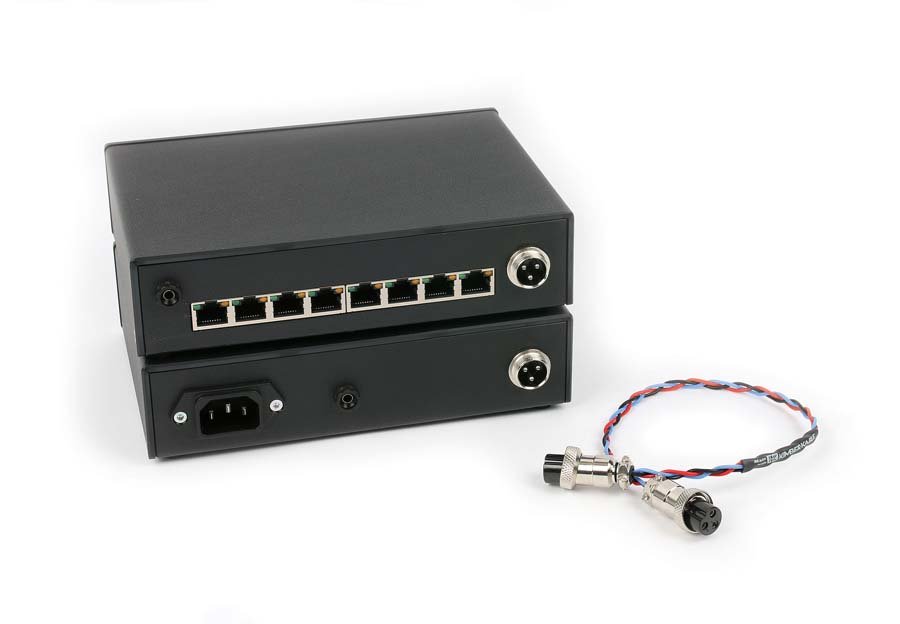
Russ Andrews RANS-1 Network Switch showing PSU and Switch unit
Listening to a Qobuz Stream of Tony Allen & Hugh Masekela’s Rejoice in 24/96, highlighted the RANS-1’s more relaxed and resolving presentation, over the 16Switch. With the latter, I noted a slightly more defined bass and was drawn more to the rhythm and timing side of the playing. Leading edges of drums and cymbals were also more pronounced, yet never harsh. Via the RANS-1 the music seemed to possess equally good timing qualities, but you had to listen for those attributes, rather than them being pointed out. A sense of ambience and acoustic space was better resolved via the RANS-1, with the drums having very slightly more sense of body. We are talking subtleties here, but easy to pick out nonetheless. With Agnes Obel’s Citizen of Glass, also a Qobuz stream but 24/44.1, I noted more definition, and a sense of instruments being ‘struck’ with the EE unit, with RANS-1 pegging things back by giving them more body and slightly more ambience. So, neither was better than the other, rather each possessed a character that might suit one potential buyer’s system over another.
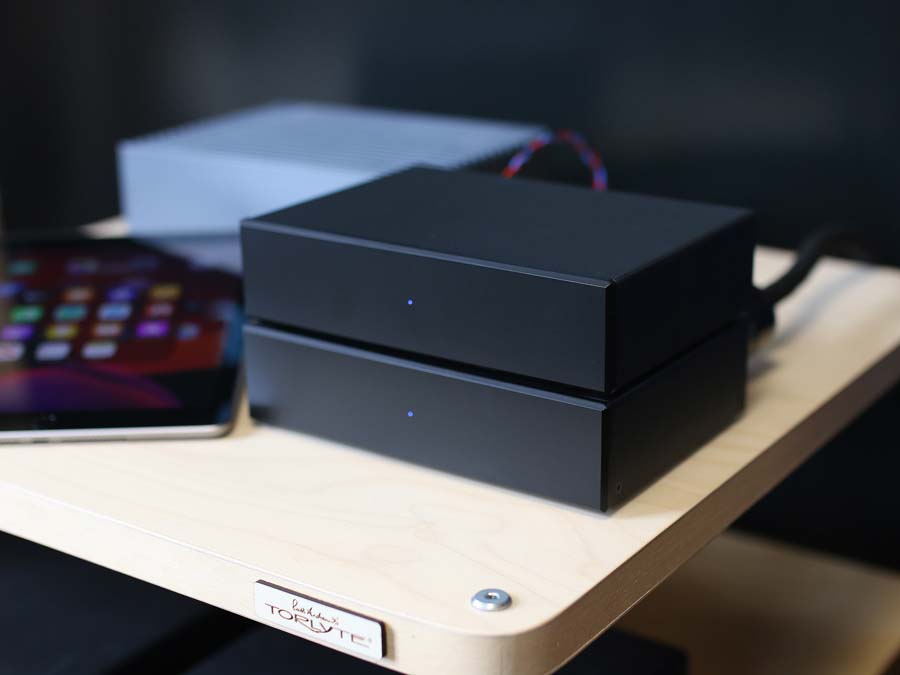
The RANS-1 in use.
CONCLUSION
I found comparing the various switches these last few weeks very enlightening. I have really enjoyed the performance of the RANS-1 and I think it looks great sitting on my corner unit with those cool blue lights! It is certainly a step above the entry-level audiophile switch I have been using in my system for the last year or so, and as you’ve read, holds its own with the competition at the higher price point. Personally, that tells me RA have got the price point right. Some may say it’s a lot of money for what is inside, but it no doubt took a lot of time to tweak to offer what is an excellent level of performance, and so I have no issues paying that sort of money, considering how it’s improved my system.
AT A GLANCE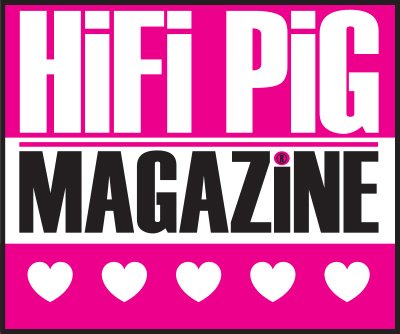
Build Quality:
Well put together and serves the intended purpose. I love the blue lights!
Sound Quality:
In theory, it does not have any! However, as mentioned in the review, in my systems, it seemed to impart the RA signature of sounding relaxed, yet detailed.
Value For Money
I think RA has got this right and it offers potential performance improvements commensurate with the price. RA offer a no quibbles return policy, so pretty much risk-free in my experience.
We Loved:
What I consider to be great looks, yet easy to hide away if needed.
It allowed a relaxed, yet detailed and musical performance from both my headphone/portable and home speaker setups.
We Didn’t Love So Much:
I can see how the price may be an issue for many.
Could be better solutions available for those who want a bit of an extra ‘kick’ in their system.
Price: £956.50 without mains cable, £989.00 with RA’s 1m yellO cable as tested.
Elevator Pitch Review: Worthy addition to the expanding audiophile switch market. I think it will delight both RA’s already contented customers and draw in new buyers, who simply love what it does for the performance of their networked systems. For me, it looks great and delivered first-class results.

Chris Baillie




























































